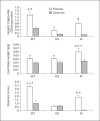Role of CYP2E1 in ethanol-induced oxidant stress, fatty liver and hepatotoxicity
- PMID: 21525766
- PMCID: PMC3211519
- DOI: 10.1159/000324289
Role of CYP2E1 in ethanol-induced oxidant stress, fatty liver and hepatotoxicity
Abstract
Background/aims: Several pathways contribute to mechanisms by which ethanol induces oxidant stress. While some studies support a role for cytochrome P450 2E1 (CYP2E1), others do not. There is a need to develop oral models of significant ethanol-induced liver injury and to evaluate the possible role of CYP2E1 in ethanol actions in such models.
Methods: We evaluated chronic ethanol-induced liver injury, steatosis and oxidant stress in wild-type (WT) mice, CYP2E1 knockout (KO) mice and in humanized CYP2E1 knockin (KI) mice, where the human 2E1 was added back to mice deficient in the mouse 2E1. WT mice and CYP2E1 KO and KI mice (both provided by Dr. F. Gonzalez, NCI) were fed a high-fat Lieber-DeCarli liquid diet for 3 weeks; pair-fed controls received dextrose.
Results: Ethanol produced fatty liver and oxidant stress in WT mice, but liver injury (transaminases, histopathology) was minimal. Ethanol-induced steatosis and oxidant stress were blunted in the KO mice (no liver injury) but restored in the KI mice. Significant liver injury was produced in the ethanol-fed KI mice with elevated transaminases and necrosis. This liver injury in the KI mice was associated with elevated oxidant stress and elevated levels of the human CYP2E1 compared to levels of the mouse 2E1 in WT mice. Activation of JNK was observed in the ethanol-fed KI mice compared to the other groups. Fatty liver in WT and KI mice was associated with lower levels of lipolytic PPAR-α. No such changes were found in the ethanol-fed KO mice.
Conclusions: These results show that CYP2E1 plays a major role in ethanol-induced fatty liver and oxidant stress. Restoring CYP2E1 in the CYP2E1 KO mice restores ethanol-induced fatty liver and oxidant stress.
Copyright © 2011 S. Karger AG, Basel.
Figures





References
-
- Nordman R, Riviere C, Rouach H. Implication of free radical mechanisms in ethanol-induced cellular injury. Free Radic Biol Med. 1992;12:219–240. - PubMed
-
- Bondy SC. Ethanol toxicity and oxidative stress. Toxicol Lett. 1992;63:231–242. - PubMed
-
- Cederbaum AI. Introduction serial review: alcohol, oxidative stress and cell injury. Free Radic Biol Med. 2001;31:1524–1526. - PubMed
-
- Arteel GE. Oxidants and antioxidants in alcohol-induced liver disease. Gastroenterology. 2003;124:778–790. - PubMed
-
- Caro AA, Cederbaum AI. Oxidative stress, toxicology and pharmacology of CYP2E1. Annu Rev Pharmacol Toxicol. 2004;44:27–42. - PubMed
Publication types
MeSH terms
Substances
Grants and funding
LinkOut - more resources
Full Text Sources
Research Materials

